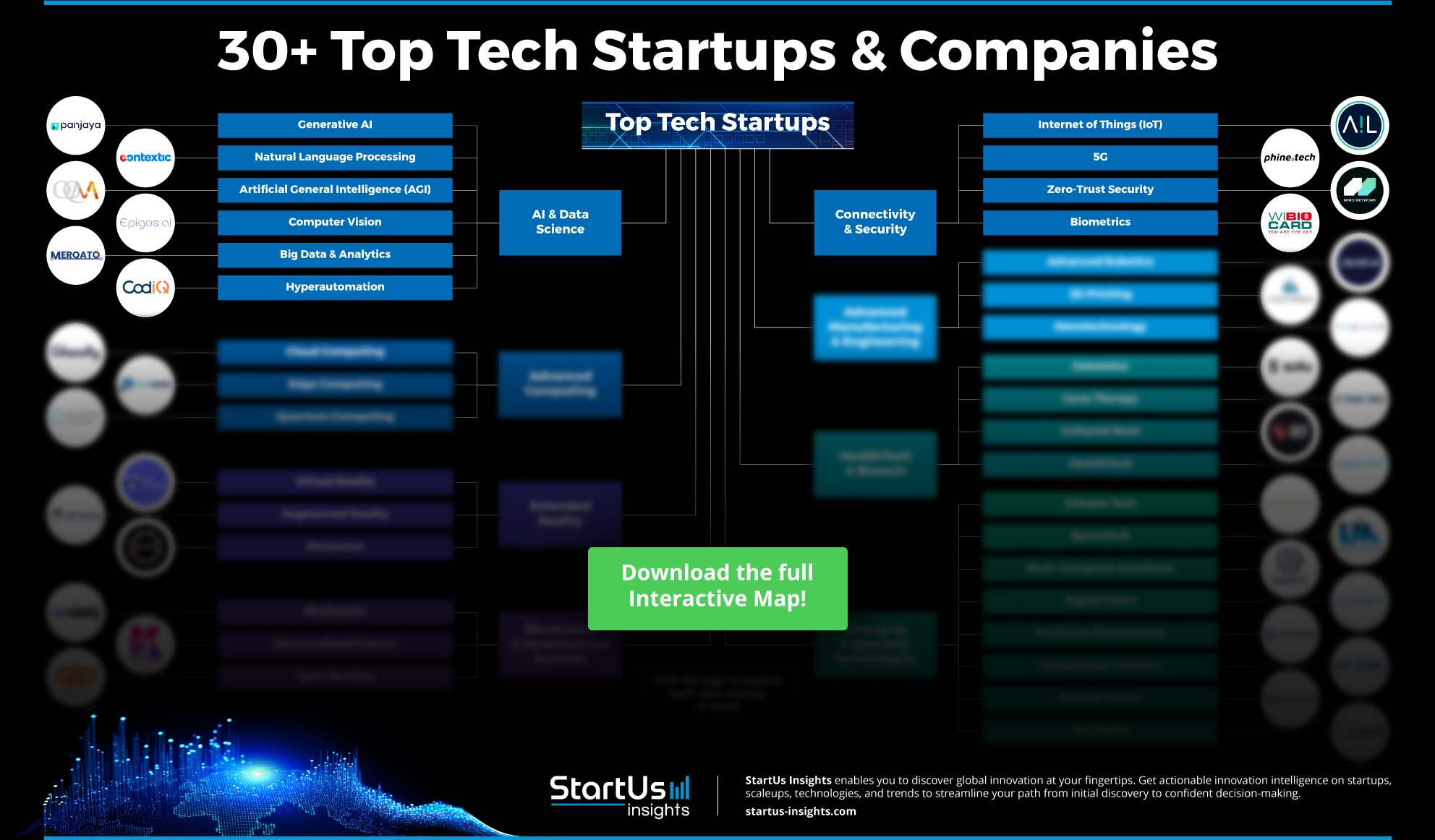Integrating AI in telecommunications industry makes operations and processes more autonomous, efficient, and sustainable. AI has opened up new ways to deal with predictive maintenance, infrastructure security, network operations, automation, and more. With technologies like natural language processing (NLP), machine learning (ML), and deep learning, AI is assisting telecom operators to stay updated with the current requirements in the telecom industry.
For example, in network slicing, AI addresses the separate requirements of the slices like different features, like security clearance, bandwidth, and speed, different levels of maintenance, and more. Similarly, telecom operators are able to connect and serve a diverse customer base with ML, which studies customer preferences, and trends, forecasts prices, demands, etc. This article covers many such examples. Read along to find out how AI contributes to such advancements in the telecom industry.
Why should you read this report?
- Gain in-depth insights into the top 8 use cases of AI in Telecom.
- Learn about three practical use cases for each use case.
- Meet 8 innovative startups advancing these applications.

Key Takeaways
- Network Planning and Optimization
- Use Cases:
- Cognitive Network Planning
- Traffic Forecasting
- Dynamic Resource Allocation
- Startup to Watch: Wan AI
- Use Cases:
- AI-driven Network Security
- Use Cases:
- User and Behavior Entity Analytics
- Automated Incident Response
- Real-Time Threat Detection
- Startup to Watch: NextRay AI
- Use Cases:
- Customer Experience Enhancement
- Use Cases:
- Chatbots and Virtual Assistants
- Network Performance Monitoring
- Customer Insights Analysis
- Startup to Watch: Ikue
- Use Cases:
- Predictive Maintenance
- Use Cases:
- Anomaly Detection
- Maintenance Cost Optimization
- Real-Time Asset Monitoring
- Startup to Watch: MLNetworks
- Use Cases:
- Call Center Automation
- Use Cases:
- Automated Call Routing
- Speech Recognition
- Performance Monitoring and Training
- Startup to Watch: Botlhale AI
- Use Cases:
- AI-powered Network Slicing
- Use Cases:
- Intelligent Slice Management
- Capacity Planning
- Quality of Service (QoS) Optimization
- Startup to Watch: Trento Systems
- Use Cases:
- Fraud Detection and Prevention
- Use Cases:
- Customer Segmentation
- Multi-Factor Authentication
- Collaborative Intelligence
- Startup to Watch: Finovox
- Use Cases:
- Marketing and Sales Optimization
- Use Cases:
- Personalized Marketing
- Dynamic Pricing
- Sales Forecasting
- Startup to Watch: Nemobile
- Use Cases:
FAQs about AI in Telecommunications
What is the future of AI in the telecom industry?
AI plays a critical role in driving automation and operational efficiency in the telecom industry. Future developments focus on improving network performance and customer experience as well as enabling predictive maintenance. AI-powered tools also optimize 5G networks, which assist the operators in managing complex infrastructures and ensuring simplified service delivery. Additionally, AI is expected to improve service personalization using real-time data to offer tailored solutions while enabling faster decision-making across business processes.
What are the current AI use cases in telecom?
Currently, telecom companies use AI in several areas to improve operational efficiency and customer satisfaction. AI-driven automation supports network management, which allows real-time adjustments to network traffic and improves reliability. Predictive maintenance identifies and resolves potential network issues before they affect performance. In customer service, AI chatbots and virtual assistants handle routine inquiries and provide continuous support. This reduces operational costs and improves response times.
How We Identify Emerging Technologies & Startups
The data in this report originates from StartUs Insights’ Discovery Platform, covering 4.7+ million global startups, scaleups, and technology companies, alongside 20K emerging technology trends. Our platform makes startup and technology scouting, trend intelligence, and patent searches more efficient by providing deep insights into the technological ecosystem. Utilizing the trend intelligence feature, we analyze industry-specific technologies for this report, detect patterns and trends, and identify use cases along with the startups advancing these areas. Further details and capabilities are accessible via the website.
Top 8 Applications of AI in Telecommunications [2025 & Beyond]
1. Network Planning and Optimization
AI-led networks detect and isolate issues automatically to enable autonomous traffic rerouting and predict future demands based on current events. AI-driven analytics improve the capabilities of self-organizing networks (SON), where networks self-configure, optimize, and heal. It also optimizes power consumption across networks by adjusting energy usage based on real-time network demands. Additionally, AI ensures intelligent load balance by distributing traffic across various network elements like servers, towers, and access points. The algorithms detect when a particular network node is nearing capacity and reroute traffic to less congested nodes. This improves spectrum management, especially in 5G networks.
Startup to Watch: Wan AI
UK-based startup Wan AI provides an AI-powered real-time network traffic management solution for 5G and 6G. WAN AI’s software automates performance optimization and ensures that targeted performance standards are consistently met for each individual data connection. This network-level technology uses AI and machine learning to generate real-time network state information (NSI), such as available bandwidth and utilization, which allows network performance optimization with minimal human intervention. Additionally, Wan AI’s concurrent event processing (CEP) system speeds up and scales Internet protocol operations.
2. AI-driven Network Security
AI promotes self-learning systems that dynamically adjust to the firewall settings, update threat databases, and block suspicious IP addresses. Professionals use this feature to improve deep packet inspection (DPI) and increase the convenience of the entire network security system by automating tasks like URL filtering, protocol protection, data loss prevention, and log analysis.
AI also tracks entity behavior, such as interactions with IoT or SIM cards, to identify devices that send unexpected signals or transmit abnormal amounts of data. Additionally, AI segments users based on behavioral data by interpolating factors like data usage, device type, app preferences, and communication patterns, which improves targeted incident response and recovery. AI-driven systems also ingest threat intelligence data like malware signatures, phishing attacks, or IP addresses associated with network security to predict potential threats.
Startup to Watch: NextRay AI
US-based startup NextRay AI offers a network detection and response (NDR) solution to simplify incident response and improve traffic visibility. It boosts endpoint security by automating lockdown and improves SIEM detections. The solution’s security orchestration, automation, and response (SOAR) further accelerates the responses by automating the workflows. Further, it integrates with legacy platforms and other security tools to offer in-depth investigation of network vulnerabilities. In addition to its advanced threat-hunting capabilities, this NDR solution enables real-time correlation across all ports and protocols, file extraction, and analysis.
3. Customer Experience Enhancement
Telecom companies leverage natural language processing (NLP) to better understand and interpret customer queries. AI also contributes to language translation to reach a larger pool of customers. By integrating real-time data with backend systems, AI further provides customers with up-to-date information on their accounts and service status, which ensures better control over usage, costs, timely alerts and notifications, etc. It enables proactive monitoring by predicting potential network failures and suggesting preventive measures, which minimizes downtime and service disruptions. Moreover, machine learning algorithms identify trends and correlations to drive targeted marketing strategies while AI-driven sentiment analysis enables companies to improve service delivery.
Startup to Watch: Ikue
UK-based startup Ikue provides a customer data platform (CDP) for the telecom industry to improve customer experience. The platform uses proprietary robotic data automation to load data into the platform. It then uses AI and machine learning to build propensity models that adapt to real-time changes in customer behavior. It ingests large volumes of data from multiple sources to assist telecom operators in maximizing customer lifetime value. This builds long-term customer relationships and drives revenue growth for mobile virtual network operators (MVNOs).
4. Predictive Maintenance
AI analyzes the real-time data collected by sensors and other IoT devices embedded in the network infrastructure for setting baseline metrics. Machine learning algorithms analyze the baseline performance metrics to detect deviations and avoid service disruptions. It monitors the health of the network and infrastructure components like antennas, routers, switches, and base stations to create proactive maintenance plans. Predictive maintenance also facilitates real-time monitoring and alerting, which allows telecom operators to respond swiftly to potential issues before they escalate. This way, AI-enabled predictive maintenance reduces labor costs and increases operational efficiency.
Startup to Watch: MLNetworks
Saudi Arabian startup MLNetworks provides SmartInsights, a data platform for telecom operators to operate and optimize their networks. The platform facilitates real-time end-to-end network visualization for instant issue identification and proactive performance optimization. It supports multiple domains like radio access networks (RAN), transport, and core networks, which eliminates silos. This vendor-agnostic platform also features topology mapping for telco operators to uncover the network’s blueprint, visualize connections, pinpoint bottlenecks, and make data-driven decisions.

5. Call Center Automation
AI predicts peak time for customers’ calls and optimizes the workforce for telecom companies. For instance, such solutions summarize call content and highlight key points along with follow-up actions like immediate troubleshooting or resource allocation. The summarized call content also provides details like increased complaints and decreased engagement, which enables businesses to predict the churn rate. Further, natural language processing understands customer queries in real time for accurate and efficient routing by identifying emotions or sentiments in speech. This dynamic routing improves the quality of customer management and improves customer experience. AI-driven systems further evaluate conversations to identify strengths, areas for improvement, and problem-solving skills of the agents to deliver personalized coaching.
Startup to Watch: Botlhale AI
South African startup Botlhale AI develops Bua, a multilingual conversational AI tool. It uses natural language processing to assist service providers in engaging with customers in multiple African languages. Bua comes with a no-code bot builder and the platform instantly translates chats. It also tracks agent performance in real time, manages chat queues, and more. The company’s other product, Vela, is an AI-powered call center analytics application programming interface (API). It is useful for language identification, multilingual transcription, and analytics gathering.
6. AI-powered Network Slicing
The telecom industry utilizes AI for network slicing in enhanced mobile broadband (eMBB), massive machine type communications (mMTC), and ultra-reliable low latency communications. Additionally, AI caters to end-to-end slicing of multi-domain networks which combines 5G, edge computing, cloud computing, and more. It also supports end-to-end orchestration of network slices and manages service level agreements (SLA) for each slice. Telecom operators further use AI to forecast future demand to automate network adjustments, reducing latency and improving user experience.
Startup to Watch: Trento Systems
South Korean company Trento Systems provides a network-slicing platform that protects data traffic and optimizes network bandwidth. The platform enables operators to create virtual networks customized for specific times, locations, devices, and services. Utilizing network slicing, the platform ensures low latency and security that traditional internet services cannot offer. These features are specifically utilized by software-defined networks (SDNs) in 5G and 6G applications.
7. Fraud Detection and Prevention
AI enhances customer segmentation, multi-factor authentication (MFA), and collaborative intelligence to detect and prevent fraud. For example, AI integrates external data, such as location and economic factors, to refine and prioritize customers while AI improves MFA by analyzing user behavior patterns to detect anomalies and strengthen authentication processes. These solutions enable adaptive authentication that adjusts security measures based on real-time risk assessments and also prevents fraud by flagging SIM swaps in mobile phones and identifying fake or stolen IDs and tampered documents to flag fraudulent activities.
Startup to Watch: Finovox
French startup Finovox provides Finovox Investigation, a SaaS platform, and Finovox Detection, an API. Finovox Investigation analyzes and investigates suspicious documents to detect fraud. On the other hand, Finovox Detection integrates into tools or interfaces to automatically detect, isolate, and sort risky documents quickly. Finovox supports the telecom sector by defrauding the subscription process and after-sales service claim management. It tracks the Know Your Customer (KYC) and Know Your Business (KYB) procedures through advanced computerized analysis, which detects indicators of machine-generated or electronically falsified documents.
8. Marketing and Sales Optimization
AI analyzes customer data including user demographics, usage patterns, and preferences to identify distinct segments within the customer base. This segmentation allows telecom companies to create targeted marketing strategies. Moreover, this enables telecom operators to simulate the impact of different pricing strategies before launch. When a competitor provider launches a new promotional price, AI detects that and recommends price adjustments. AI also adjusts prices in remote or rural areas where the network competition is limited. These dynamic strategies and planning improve customer engagement and lead to an increased retention rate.
Startup to Watch: Nemobile
Portuguese startup Nemobile offers SIDIS, a platform that improves sales management and customer resource management (CRM) in the telecom industry. The platform integrates with business applications to automate workflows and centralize structured and unstructured data. It offers fully customizable dashboards and reports through Google Data Studio, which allows businesses to connect, visualize, and share data easily for better decision-making. Further, the platform predicts customer behavior, analyzes digital footprints, and assesses campaign effectiveness to provide insights on customer conversion, profiling, and sentiment analysis.
Leverage Emerging Telecom Technologies
Top investors like Y Combinator, Techstars, Creative Destruction Lab, Plug and Play, Entrepreneur First support startups focusing on AI applications in telecom industry. They provide crucial funding that drives innovation. This funding majorly spans seed, pre-seed, and series A rounds. Whereas, the average funding per round stands at USD 18.4 million, supporting early-stage startups developing AI-powered solutions advancing telecom.
Act now on the emerging technologies transforming the telecom industry. With StartUs Insights, you swiftly discover hidden gems among over 4.7 million startups, scaleups, and tech companies, supported by 20,000 trends and technologies. Our AI-powered search and real-time database ensure exclusive access to innovative solutions, making the global innovation landscape easy to navigate.
Trusted by industry leaders like Samsung, Nestlé, and Magna, we provide unmatched data, a 360-degree industry view, and data-driven intelligence for confident strategic decisions. Leverage our innovation services to optimize costs, streamline operations, and stay ahead of the curve. Get in touch today to explore how our comprehensive innovation intelligence can drive your success.
Discover All AI-led Telecom Innovations & Startups!








